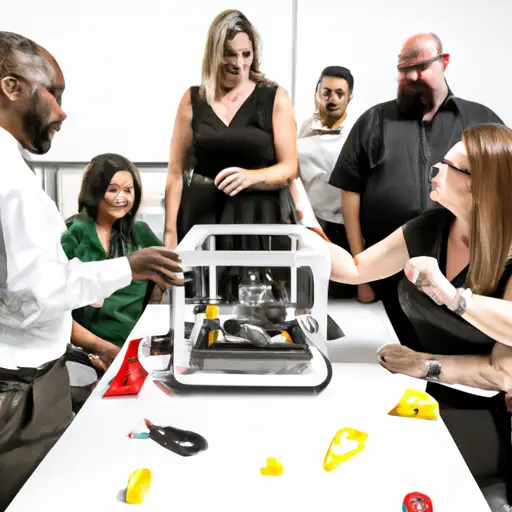Like gears seamlessly interlocking to power a machine, collaborations and partnerships are the driving force behind innovation in the dynamic 3D printing ecosystem.
This article explores the strategic alliances and cooperative efforts that have propelled the industry forward, expanding the possibilities of material development, shaping the future through academia, and joining forces between manufacturers and software developers.
By examining the environmental benefits and global collaborations in 3D printing, we unlock the potential for unlocking new markets and revolutionizing industries.
The Power of Collaboration: Driving Innovation in 3D Printing
Collaboration plays a pivotal role in propelling innovation within the realm of 3D printing. In this era of open innovation, companies are increasingly recognizing the importance of working together to drive advancements in this rapidly evolving technology. Through collaborative research efforts, organizations are able to pool resources, knowledge, and expertise to overcome technical challenges, explore new applications, and accelerate the development of 3D printing technologies.
Open innovation, characterized by the sharing of ideas and collaboration among different stakeholders, has become a hallmark of the 3D printing ecosystem. Companies are actively engaging in partnerships with academic institutions, research organizations, and industry peers to collectively push the boundaries of what is possible with 3D printing. This collaborative approach allows for the exchange of ideas and perspectives, fostering a rich environment for innovation.
Collaborative research efforts enable organizations to leverage each other’s strengths, resulting in more efficient and effective problem-solving. By pooling resources and expertise, researchers can tackle complex challenges that would be difficult to address individually. Furthermore, collaboration facilitates the cross-pollination of ideas, enabling researchers to draw inspiration from different disciplines and industries.
The power of collaboration in driving innovation in 3D printing is evident in the numerous success stories that have emerged from collaborative research endeavors. From advancements in material science to the development of new printing techniques, collaborative efforts have been instrumental in pushing the boundaries of what can be achieved with 3D printing technology. As the field continues to evolve, collaboration will remain a crucial component in unlocking the full potential of 3D printing.
Forming Strategic Partnerships: Creating a Strong 3D Printing Ecosystem
Establishing strategic partnerships is essential for creating a robust and interconnected 3D printing ecosystem. These strategic alliances bring together the expertise, resources, and technologies of different companies, fostering innovation through collaboration. By pooling their strengths, companies can leverage each other’s capabilities and accelerate the development and adoption of 3D printing technologies.
One of the key benefits of strategic partnerships in the 3D printing ecosystem is the ability to access a broader range of expertise. Different companies bring unique perspectives and knowledge to the table, allowing for the exchange of ideas and the development of new solutions. This collaborative approach can lead to breakthrough innovations that may not have been possible otherwise.
Strategic partnerships also enable companies to share resources and infrastructure, reducing costs and increasing efficiency. By combining manufacturing capabilities, companies can optimize production processes and scale up operations more effectively. This can result in lower costs for consumers and faster time-to-market for new products.
Furthermore, strategic partnerships can facilitate the sharing of intellectual property and the development of industry standards. This encourages interoperability and compatibility between different 3D printing systems, making it easier for companies to collaborate and for end-users to adopt the technology.
Collaborative Efforts in Material Development: Expanding the Possibilities of 3D Printing
The integration of advanced materials and the utilization of sustainable resources are key drivers in expanding the possibilities of 3D printing. Collaborative efforts in material development have become crucial to drive material innovation and additive manufacturing advancements.
In recent years, there has been a significant focus on developing new materials specifically designed for 3D printing. This has led to the creation of innovative materials that offer enhanced properties such as strength, durability, and flexibility. Researchers and industry experts are collaborating to explore the potential of materials like metal alloys, ceramics, and composites, which can be used in various industries including aerospace, automotive, and healthcare.
One example of material innovation in 3D printing is the development of biodegradable and sustainable materials. With the growing concern for the environment, there is a rising demand for eco-friendly materials that can be used in additive manufacturing processes. Collaborations between material suppliers, researchers, and manufacturers have resulted in the creation of materials derived from renewable sources, such as bio-based polymers and recycled plastics.
Moreover, collaborative efforts have also been focused on improving the compatibility between materials and 3D printing technologies. Research institutions and companies are working together to optimize material formulations and develop printing parameters that ensure high-quality prints. These advancements enable the creation of complex geometries and intricate structures with improved accuracy and precision.
The Role of Universities in Shaping the Future of 3D Printing
Universities play a pivotal role in driving innovation and research, contributing to the shaping of the future of 3D printing. With their extensive research facilities and expert faculty, universities are at the forefront of exploring new applications and pushing the boundaries of 3D printing technology. Their research impact is evident in the numerous breakthroughs and advancements made in the field.
One way universities contribute to the future of 3D printing is through educational partnerships. These partnerships involve collaborations between universities and industry leaders, allowing students to gain hands-on experience and exposure to the latest advancements in 3D printing. By working closely with industry professionals, students are better equipped to enter the workforce and contribute to further innovation in the field.
Universities also play a crucial role in developing the next generation of 3D printing professionals. Through dedicated programs and courses, students are provided with the necessary skills and knowledge to excel in this rapidly evolving industry. By nurturing talented individuals and providing them with the resources they need, universities are ensuring a steady supply of skilled professionals who will shape the future of 3D printing.
Joining Forces: Manufacturers and Software Developers in the 3D Printing Industry
One important aspect of the 3D printing industry is the collaboration between manufacturers and software developers. This collaboration brings together their expertise and resources to drive advancements in the field.
Manufacturers and software developers play crucial roles in the development and growth of the 3D printing industry. The collaboration between these two entities has led to significant advancements in technology, enabling the industry to expand and grow at a rapid pace.
Manufacturers in the 3D printing industry are responsible for designing and producing the hardware necessary for the printing process. They work closely with software developers to ensure that their hardware is compatible with the software used to create and manipulate 3D designs.
On the other hand, software developers play a key role in developing the software that enables users to create, modify, and print 3D models. They work with manufacturers to optimize their software for specific hardware, ensuring seamless integration and optimal performance.
The collaboration between manufacturers and software developers has resulted in improved printing capabilities, increased precision, and enhanced user experience. This has further contributed to the market expansion and growth of the 3D printing industry.
Collaborating for Sustainability: Environmental Benefits of Partnerships in 3D Printing
Collaborating for sustainability, we can see that partnerships in the 3D printing industry offer numerous environmental benefits. One of the key advantages of such collaborations is waste reduction. By pooling resources and expertise, partners can develop innovative strategies to minimize waste throughout the 3D printing process. This can include optimizing material usage, implementing recycling programs, and finding creative ways to reuse or repurpose excess materials.
Sustainable manufacturing collaborations also play a crucial role in reducing the environmental impact of 3D printing. When manufacturers partner with software developers, they can work together to develop more energy-efficient printing processes and optimize printer settings for minimal resource consumption. By leveraging advanced software algorithms and machine learning, printing parameters can be fine-tuned to achieve the desired results while minimizing energy and material usage.
Moreover, partnerships in the 3D printing industry facilitate the development and adoption of more sustainable materials. By collaborating with material suppliers, 3D printing companies can influence the development of eco-friendly alternatives to traditional plastics and metals. This paves the way for the production of more sustainable and biodegradable 3D-printed products.
Unlocking New Markets: Exploring Global Collaborations in 3D Printing
Unlocking new markets through global collaborations in 3D printing offers several key opportunities.
First, cross-border manufacturing networks enable companies to tap into new regions, accessing local expertise and reducing production costs.
Second, international distribution opportunities allow for wider market reach and increased sales potential.
However, cultural considerations in partnerships are crucial to ensure successful collaborations, as understanding local customs and preferences can significantly impact market acceptance and adoption.
Cross-Border Manufacturing Networks
As companies in the 3D printing industry continue to expand their operations globally, they are increasingly turning to cross-border manufacturing networks to tap into new markets and leverage global collaborations. These networks allow companies to establish global supply chains and enhance their manufacturing efficiency by taking advantage of specialized expertise and resources available in different regions. By partnering with manufacturers in different countries, companies can reduce costs, shorten production lead times, and gain access to new customer bases. Moreover, cross-border manufacturing networks enable companies to overcome logistical and regulatory barriers that may exist in certain markets. This strategic approach not only expands market reach but also promotes innovation and knowledge sharing across borders. As a result, companies in the 3D printing industry are able to unlock new opportunities and drive growth in the global marketplace.
| Benefits of Cross-Border Manufacturing Networks | Examples |
|---|---|
| Reduced costs and production lead times | Company A partners with a manufacturer in China to take advantage of low labor costs and fast production capabilities |
| Access to specialized expertise and resources | Company B collaborates with a manufacturer in Germany to leverage their advanced technology and engineering capabilities |
| Expansion into new customer bases | Company C establishes a partnership with a manufacturer in Brazil to enter the South American market and reach a new customer segment |
| Overcoming logistical and regulatory barriers | Company D forms a collaboration with a manufacturer in India to navigate complex import/export regulations and ensure smooth operations |
International Distribution Opportunities
With the rapid growth of the 3D printing industry, opportunities for international distribution have emerged, allowing companies to explore new markets and establish global collaborations.
International distribution offers several advantages, including market expansion and access to a wider customer base. By entering new markets, companies can tap into the growing demand for 3D printed products and services in different regions around the world. This not only helps in diversifying revenue streams but also reduces the reliance on a single market.
Additionally, international distribution enables companies to take advantage of cost efficiencies such as lower labor costs or access to raw materials in different countries. Collaborating with local partners or distributors can further enhance market reach and provide valuable insights into local customer preferences and cultural nuances.
As the 3D printing industry continues to expand, international distribution will play a crucial role in driving growth and unlocking new opportunities for companies in this ecosystem.
Cultural Considerations in Partnerships
Effective partnerships in the global 3D printing ecosystem require careful consideration of cultural factors to ensure successful market penetration and collaboration. Cross-cultural communication plays a crucial role in building strong partnerships and avoiding misunderstandings. Understanding the cultural nuances of potential partners can help bridge gaps and foster effective communication.
Shared values are another important aspect to consider when forming partnerships. When partners share similar values and beliefs, it becomes easier to align goals and work towards a common vision. Research has shown that partnerships built on shared values tend to be more successful and have higher levels of trust and cooperation.
Therefore, when exploring global collaborations in the 3D printing industry, it is essential to prioritize cultural considerations and find partners with whom there is a mutual understanding and alignment of values.
Frequently Asked Questions
What Are the Major Challenges Faced in Collaborative Efforts Within the 3D Printing Ecosystem?
The major challenges faced in collaborative efforts within the 3D printing ecosystem include lack of standardized processes, intellectual property concerns, and limited access to resources. Solutions involve establishing industry-wide guidelines, legal frameworks, and fostering knowledge sharing platforms.
How Do Strategic Partnerships Contribute to the Growth and Advancement of 3D Printing Technology?
Strategic partnerships play a crucial role in the growth and advancement of 3D printing technology. By leveraging complementary resources, expertise, and distribution channels, these collaborations enable faster innovation, expanded market reach, and accelerated adoption of the technology.
What Are Some Examples of Successful Collaborations in Material Development for 3D Printing?
Successful collaborations in material development for 3D printing have led to the creation of innovative materials that push the boundaries of what is possible. These partnerships have resulted in the development of materials with enhanced properties, improved performance, and expanded applications in various industries.
How Do Universities Play a Crucial Role in Shaping the Future of 3D Printing?
Universities play a crucial role in shaping the future of 3D printing through their research and innovation in academia. They contribute to advancements in material development, technology, and application, driving the growth and transformation of the 3D printing ecosystem.
Can You Provide Specific Examples of Successful Collaborations Between Manufacturers and Software Developers in the 3D Printing Industry?
Examples of successful collaborations between manufacturers and software developers in the 3D printing industry include Formlabs partnering with Autodesk and Ultimaker collaborating with Siemens. These partnerships have resulted in the development of innovative products and improved workflow integration.
Conclusion
In conclusion, collaborations and partnerships have become essential in the 3D printing ecosystem, driving innovation, expanding possibilities, and unlocking new markets.
Like gears in a well-oiled machine, these collaborations create a strong and interconnected network that fuels the growth of the industry.
By joining forces, manufacturers, software developers, universities, and other stakeholders are able to overcome challenges, develop new materials, and contribute to the sustainability and global reach of 3D printing.
This collaborative approach ensures a bright future for the industry, where creativity and technological advancements continue to flourish.




